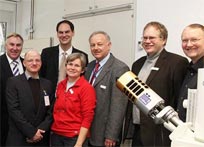Feb 16 2011
The capability of an energy dispersive spectroscopy (EDS) sensor to garner miniscule X-ray counts at the nano-metre scale is a necessity, crucial to its success. This need becomes even more pronounced when beam currents from a microscope have to be minimized to maintain the output integrity.
 Oxford's EDS
Oxford's EDS
Oxford Instruments NanoAnalysis, a developer of Energy Dispersive Spectroscopy systems for electron microscopes, has erected its 1000th X-Max at Atotech in Berlin, Germany, along with three other X-Max units. The system provides an 80mm2 sensor area. The system is a large area silicon drift detector.
According to Ian Barkshire, managing director, stated that as a viable venture Oxford Instruments aspires to exploit innovation to transform intelligent science into outstanding products. The system was installed at Atotech in Berlin, Germany, during January 2011. Atotech is a company that manufactures integrated production systems deployed for semiconductor and printed circuit board production. Tests conducted at the time of installation showed that the system adhered to the 124eV specifications, remaining within prescribed norms.